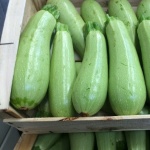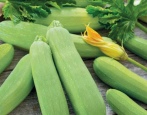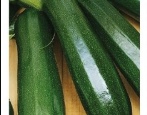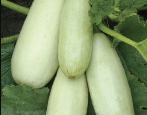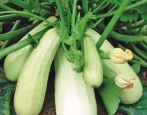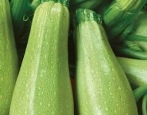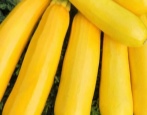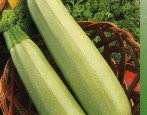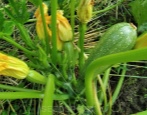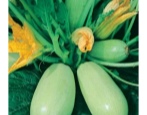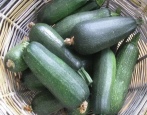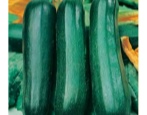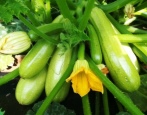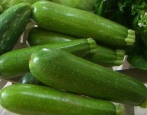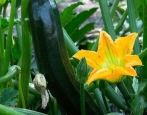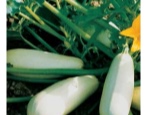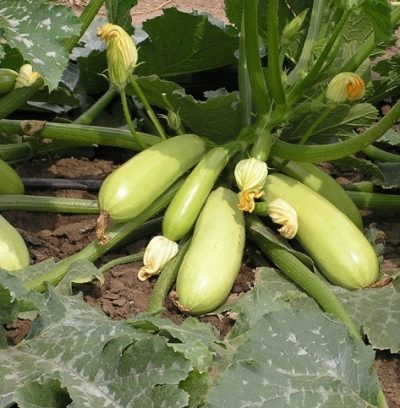
- Name synonyms: Escanderany
- Year of approval: 2006
- Ripening terms: early maturing
- The period from germination to harvest: 39-41 days
- Description of the plant: compact
- Leaves: medium to large, light green to dark green, moderately dissected, mottled
- Fruit shape: clavate
- Fruit color: light green with white spot
- Color of the pulp: creamy white
- Pulp (consistency): dense, delicate
Zucchini, representatives of the melon family, are always loved by gardeners and gardeners. More and more new varieties and hybrids appear on the seed market. Iskander Zucchini, synonymous with Escanderany, is a new generation Dutch hybrid designed for outdoor cultivation. The culture is characterized by excellent productivity, unpretentiousness, attractive appearance and pleasant taste. In the State Register of Breeding Achievements, the hybrid was registered in 2006 as a crop approved for cultivation in climatic zone 8 - Lower Volga region.
Description of the variety
Iskander is a zucchini with a rich chemical composition. This hybrid is characterized by an extremely low calorie content, complete absence of cholesterol and fatty acids, which makes the product a popular component in the preparation of diets. The main component of its structure is moisture, everything else consists of micro-, macroelements, such as:
copper;
iron;
phosphorus;
calcium;
potassium and others.
It contains a lot of carbohydrates, fiber, vitamins E and B, as well as pectin, ascorbic acid, tocopherol and biotin. The culture is grown not only on private plots, but also on farms for seasonal sale in retail outlets.
Characteristics of the appearance of plants and fruits
Zucchini belongs to bush hybrid varieties and has a compact habit. Medium-sized dark green leaves with an average degree of dissection have a pronounced spotting on the surface of the plate. The lower part of the leaf is painted in lighter colors. The hybrid gives few lashes, but this does not affect its yield in any way, whose performance is beyond praise. The club-shaped, leveled fruits reach an average size: 15-20 centimeters in length and 700-800 grams in weight. The surface of the zucchini is smooth, slightly glossy, on a light green background, spots are observed, like leafy ones. The seeds are almost white, have an elliptical outline and are medium in size, and have an oily, slightly sweet taste with a nutty flavor when slightly roasted.
Purpose and taste
Iskander fruits are intended for cooking vegetable stews and other dishes, for canning and deep freezing. The dense and delicate pulp is colored in a creamy white shade, characterized by a mild pleasant taste.
Ripening terms
The vegetable belongs to the early ripening category - from the first shoots to the first fruits that have reached technical ripeness, it takes 39-41 days, but these are average indicators. More exact dates depend on the climatic characteristics of the growing region. Despite the fact that the hybrid is intended for growing in the open field, it can be grown under a film, which will further shorten the time, or will not allow a strong delay if the vegetable is growing in the northern regions.
Yield
Iskander is distinguished by high yield rates - on average, 12-15 kilograms of zucchini are removed from one square meter.
Growing regions
Initially, the Dutch hybrid was considered adapted to the Lower Volga regions, but resistance to cold allowed it to spread almost throughout the country.These are the Far Eastern, West Siberian, Northwestern, Volgo-Vyatka, Ural, Central, Central Black Earth regions, North Caucasian, Middle Volga, East Siberian regions.
Growing and care
For growing zucchini, two methods are used - seedling and direct sowing into the ground. The optimal timing for both methods depends entirely on the climatic characteristics of the environment. With the seedling method, the owner of the site will be able to get the first fruits 2-3 weeks earlier than when sowing in the ground. Sowing for seedlings is carried out approximately one month before the planned transplant in the exhaust gas. To provide the upper and underground parts with adequate lighting and nutrition, plants should be placed at a distance of 60 centimeters from each other and 1.5-2 meters between rows. Ready seedlings are transplanted into holes 15-20 deep and about 30 cm wide. Further care consists in traditional agrotechnical measures.
Watering. Despite its drought resistance, the hybrid will not be able to fully bear fruit without proper moisture. Irrigation should be regular and abundant - you should not allow the land to dry out. In hot weather and in the absence of rain for a long time, up to 20 liters of water is poured onto one bush. Watering is especially important at the beginning of the growing season, budding and fruit set. The water should be warm, watering is carried out at the very root to avoid moisture getting on the leaves and subsequent rotting of the ovaries.
Top dressing. Even if the planting hole was filled with nutrients in the proper measure, powerful bushes very quickly deplete stocks. Regular feeding will significantly increase the yield. It is best to feed the plant at least three times per season:
for the first time, this is done when 3-4 true leaves appear (20 g of potassium and ammonium nitrate, 40 g of superphosphate per 10 liters of water);
the second time when ovaries appear (50 g of superphosphate and 50 g of potassium nitrate / 10 l of water);
during active fruiting, zucchini especially need additional nutrients - when feeding, they use the same scheme as for the second application.
Spraying. In this case, gardeners have several goals:
treatment for parasites and diseases;
foliar feeding;
increasing immunity and attracting pollinating insects.
For this, fungicides, insecticides, boric acid and sugar solutions, folk recipes for infusions, for example, onion and garlic husks, as well as an extract from wood ash, are used to significantly increase immunity.
Loosening will help prevent the formation of an earthen crust that impedes the access of oxygen, mulching counteracts moisture evaporation and delays the development of weeds. Weeding removes the competition for nutrients from the crop.
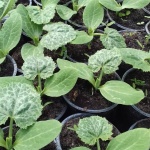

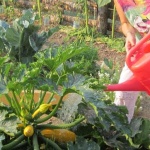
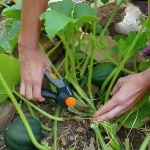
Soil requirements
Zucchini develops poorly and bears fruit on acidic soils, therefore, when choosing a site for planting, close attention should be paid to this factor.The vegetable loves sunny places without close proximity to groundwater or marshy lowlands. Good predecessors are all types of nightshades, as well as onions, garlic, legumes. Neighborhood with pumpkins is contraindicated. When preparing the site, you should take care of the fertility of the earth: add humus or compost, azophoska, humic fertilizer and wood ash to the hole. If the soil is heavy, then it should be loosened with river sand, high peat, agroperlite or vermiculite.
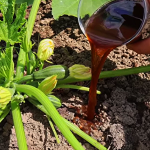
Required climatic conditions
The hybrid perfectly tolerates short-term droughts and cold snaps, therefore, it does not impose special requirements on climatic conditions, except for standard agricultural technology.
Disease and pest resistance
Iskander has strong immunity and successfully resists many diseases. Of the pests, they can harm him:
whitefly;
melon aphid;
spider mite.
As a preventive measure, insecticide treatment is recommended. To avoid damage by anthracnose, powdery mildew, peronosporosis and gray rot, in order to prevent planting, it should be treated with fungicides.
